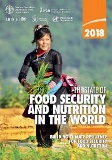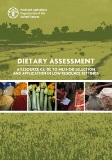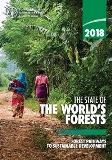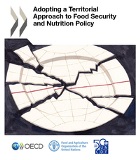Accelerate > Publications
Search this online library featuring the latest FAO publications, issue papers and briefs which offer up-to-date knowledge and innovative insights for SDG acceleration.

The State of Food Security and Nutrition in the World 2018 - Building climate resilience for food security and nutrition
2018
New evidence this year corroborates the rise in world hunger observed in this report last year, sending a warning that more action is needed if we aspire to end world hunger and malnutrition in all its forms by 2030. Updated estimates show the number of people who suffer from hunger has been growing over the past three years, returning to prevailing levels from almost a decade ago..

Ending extreme poverty in rural areas - Sustaining livelihoods to leave no one behind
2018
Sustainable Development Goal 1, ending poverty in all its forms, everywhere, is the most ambitious goal set by the 2030 Agenda. This Goal includes eradicating extreme poverty in the next 12 years, which will require more focused actions in addition to broad-based interventions. The question is: How can we achieve target 1.1 and overcome the many challenges that lie ahead?

Dietary assessment - A resource guide to method selection and application in low resource settings
2018
FAO provides countries with technical support to conduct nutrition assessments, in particular to build the evidence base required for countries to achieve commitments made at the Second International Conference on Nutrition (ICN2) and under the 2016-2025 UN Decade of Action on Nutrition. Such concrete evidence can only derive from precise and valid measures of what people eat and drink.

The State of World Fisheries and Aquaculture 2018 - Meeting the sustainable development goals
2018
The 2018 edition of The State of World Fisheries and Aquaculture emphasizes the sector’s role in achieving the 2030 Agenda for Sustainable Development and the Sustainable Development Goals, and measurement of progress towards these goals. It notes the particular contributions of inland and small-scale fisheries, and highlights the importance of rights-based governance for equitable and inclusive development.

The State of Food and Agriculture 2018 - Migration, agriculture and rural development
2018
Migration is an expanding global reality, one that allows millions of people to seek new opportunities. But it also involves challenges for migrants and for societies, both in areas of origin and of destination. This report analyses migratory flows – internal and international – and how they are linked to processes of economic development, demographic change, and natural-resource pressure.

The State of the World’s Forests 2018 - Forest pathways to sustainable development
2018
This edition of The State of the World’s Forests is aimed at enhancing our understanding of how forests and their sustainable management contribute to achieving several of the SDGs. Time is running out for the world’s forests: we need to work across sectors, bring stakeholders together, and take urgent action. The State of the World’s Forests 2018 identifies actions that can be taken to increase the contributions of forests and trees that are necessary to accelerate progress towards the SDGs.

World Livestock: Transforming the livestock sector through the Sustainable Development Goals
2018
The report “Transforming the livestock sector through the sustainable development goals” examines the sector’s interaction with each of the SDGs, as well as the potential synergies, trade-offs, and complex interlinkages involved. The publication is intended to serve as a reference framework for Member States as they move forward to realize livestock’s potentially major contribution to the Agenda 2030.

Progress on Water-use Efficiency. Global baseline for SDG indicator 6.4.1
2018
Access to safe water and sanitation and sound management of freshwater ecosystems are at the very core of sustainable development. This report describes the methodology for the assessment of SDG indicator 6.4.1 on water use efficiency, illustrating its development in the pilot phase of the GEMI project and the technical steps needed to apply it.

City Region Food Systems and Food Waste Management
2017
This book describes the results of 13 case studies on city region food systems and food waste management. It provides lessons learned on the institutionalisation of city region food policies and programmes; provisioning of national and legal frameworks embedding city region food systems in broader legislation, on strengthening of coordination and collaboration across horizontal and vertical government levels, and on design of specific programmes and policies for sustainable city region food...

The State of Food and Agriculture 2017 - Leveraging food systems for inclusive rural transformation
2017
One of the greatest challenges today is to end hunger and poverty while making agriculture and food systems sustainable. The challenge is daunting because of continued population growth, profound changes in food demand, and the threat of mass migration of rural youth in search of a better life. This report presents strategies that can leverage the potential of food systems to become the engine of inclusive economic development and rural prosperity in low-income countries.

Strategic work of FAO to reduce rural poverty
2017
FAO helps countries achieve SDG1 (No poverty) and SDG2 (Zero hunger) by improving the livelihoods of poor and extreme poor rural people, including smallholders and family farmers.

The State of Food Security and Nutrition in the World 2017 - Building Resilience for Peace and Food Security
2017
This year’s The State of Food Security and Nutrition in the World warns that the long-term declining trend in undernourishment seems to have come to a halt and may have reversed, largely on account of the above-mentioned factors. Meanwhile, though progress continues to be made in reducing child malnutrition, rising overweight and obesity are a concern in most parts of the world.

Adopting a Territorial Approach to Food Security and Nutrition Policy
2016
Three-quarters of the world’s extreme poor live in the rural areas of developing countries. This marks not only the scope of the problem, but also identifies a territorial divide. And, not all rural areas are alike. Most rural poor and food insecure live in sub-national regions that are disadvantaged in many other ways: they lack adequate infrastructure and basic services and are more vulnerable to adverse climatic conditions. Continued population growth brings added pressure to..

Guidelines on urban and peri-urban forestry
2016
These guidelines are the result a consultative process that involved a large number of practitioners from both developed and developing countries. Two meetings were held in Glasgow and Delhi and a tentative outline was agreed upon. The guidelines are intended to provide a reference framework for decision makers and planners to adequately plan, design and manage the forest and trees in and around their cities.

The State of World Fisheries and Aquaculture - 2016 - Contributing to food security and nutrition for all
2016
This issue of The State of World Fisheries and Aquaculture aims to provide objective, reliable and up-to-date data and information to a wide range of readers – policy-makers, managers, scientists, stakeholders and indeed all those interested in the fisheries and aquaculture sector. As always, the scope is global and the topics many and varied.

The State of Food and Agriculture 2016 - Climate change, agriculture and food security
2016
The 2016 SOFA report presents evidence on today and tomorrow’s impact of climate change on agriculture and food systems. The report assesses the options to make agriculture and food systems resilient to climate change impacts, while minimizing environmental impacts. It shows that making agriculture and food systems sustainable is both economically and technically feasible.

Handbook on Food Labelling to Protect Consumers
2016
Food labelling is useful tool to protect consumer health and to prevent fraudulent practices. The handbook explains the general principles and good practices for food labelling, including international standards for labelling.

Voluntary Guidelines for Securing Sustainable Small-Scale Fisheries in the Context of Food Security and Poverty Eradication
2015
The Voluntary Guidelines for Securing Sustainable Small-Scale Fisheries in the Context of Food Security and Poverty Eradication (SSF Guidelines) represent the first ever international instrument dedicated to small-scale fisheries. They represent a global consensus on principles and guidance for small-scale fisheries governance and development.
Browse by SDG
- SDG1: No Poverty
- SDG2: Zero Hunger
- SDG3: Good Health & Well-being
- SDG4: Quality Education
- SDG5: Gender Equality
- SDG6: Clean Water & Sanitation
- SDG7: Affordable and Clean Energy
- SDG8: Decent Work and Economic Growth
- SDG9: Industry, Innovation and Infrastructure
- SDG10: Reduced Inequalities
- SDG11: Sustainable Cities and Communities
- SDG12: Responsible Consumption and Production
- SDG13: Climate Action
- SDG14: Life Below Water
- SDG15: Life on Land
- SDG16: Peace, Justice and Strong Institutions
- SDG17: Partnerships for the Goals
Browse by Better
Browse by Priority Area
- Innovation for Sustainable Agriculture Production
- Blue Transformation
- One Health
- Small-Scale Producers' Equitable Access to Resources
- Digital Agriculture
- Healthy Diets for All
- Nutrition for the Most Vulnerable
- Safe Food for Everyone
- Reducing Food Loss and Waste
- Transparent Markets and Trade
- Climate Change Mitigating and Adapted Agrifood Systems
- Bioeconomy for Sustainable Food and Agriculture
- Biodiversity and Ecosystem Services for Food and Agriculture
- Achieving Sustainable Urban Food Systems
- Gender Equality and Rural Women's Empowerment
- Inclusive Rural Transformation
- Agriculture and Food Emergencies
- Resilient Agrifood Systems
- Hand-in-Hand Initiative
- Scaling up Investment
